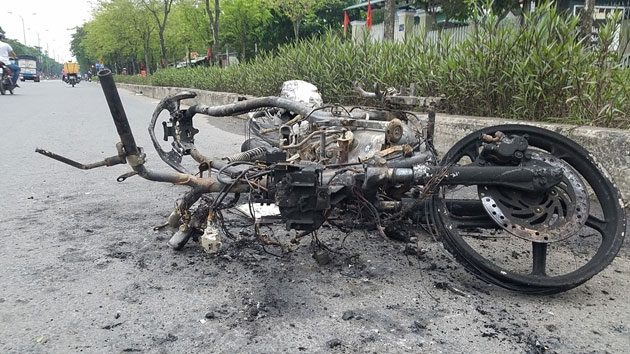After turning off the engine, the power supply from the battery remains connected to electrical devices.
“Many people still think that when the engine is off, there is no power supply, and fires cannot occur. This is a misconception because when the ignition is turned off, the power supply to the engine’s ignition system is interrupted, but the power supply from the battery to the lights and control devices remains active and can definitely cause fires…” – Lieutenant Colonel Le Manh Ha, Deputy Head of the Legal Department, Fire Investigation and Fire Prevention (HCMC Fire Department), stated.
Countless Causes
“A garment worn for a long time can tear at any time, and the same goes for vehicles” – Mr. Ha compared.
He explained: “There are many reasons why cars and motorcycles catch fire: due to friction (when brakes are stuck); during repair or assembly, the engine may crack, leading to fuel leaks; electrical equipment on the vehicle may short-circuit; and insecure electrical connections…”
In particular, users who install additional lights, flashing lights, sirens, and speakers can cause overloads; faults in parts, thermal impacts damaging the vehicle’s wiring, and rodents gnawing on the wiring can also lead to fires.
“Vehicles that are not running but catch fire mostly stem from issues in the electrical wiring. For motorcycles, the ignition switch is usually at the front, and the battery is located in the body, so when a malfunction occurs, it can ignite the fuel line, causing the fire to spread rapidly.”

There are many causes of car and motorcycle fires.
How to Prevent Fires?
Mr. Ha recommends: “If the vehicle is left unused in the house for a long time, it’s best to drain the fuel or remove the battery.”
Vehicles stored indoors should maintain a certain distance from each other and from flammable materials such as paper, curtains, mattresses, and wooden partitions. Never store motorcycles under staircases, as this can block escape routes in case of a fire.
When inspecting or repairing vehicles, it’s important to check the wiring and the battery for any signs of swelling or damage.
Signs to watch for include abnormal electrical wiring such as uneven insulation, blistering, loose contact points, dirt accumulation, or wear from rubbing against the vehicle’s frame, which should be addressed immediately.
If a vehicle frequently drains the battery, the wiring may show signs of melting or blistering. In this case, it’s essential to check the vehicle’s frame relay (the component that charges the battery) as this could be the main cause of wiring damage, leading to short circuits.
Every household should install fire alarms in appropriate areas, equip portable fire extinguishers, and personal protective equipment such as gas masks, fire blankets, and escape ropes.
The most economical and simplest method is to always keep a bucket of water in the bathroom for fire emergencies. If a vehicle catches fire and gasoline has not leaked into the house, using water can still be very effective. However, if gasoline has spilled into the house, using water to extinguish the fire may cause it to spread to other areas.
“In case of a fire or explosion, call 114 immediately. Don’t wait until you can’t extinguish it yourself before calling, as it may be too late. It is crucial for people to recognize that motorcycles and cars are dangerous fire sources, so they should be organized neatly and logically, ensuring they do not block escape routes and allowing for clear exits. For instance, ask yourself: If a vehicle catches fire in that position, will it spread? Can my family escape, and through which exit?” – Lieutenant Colonel Le Manh Ha shared.





















































